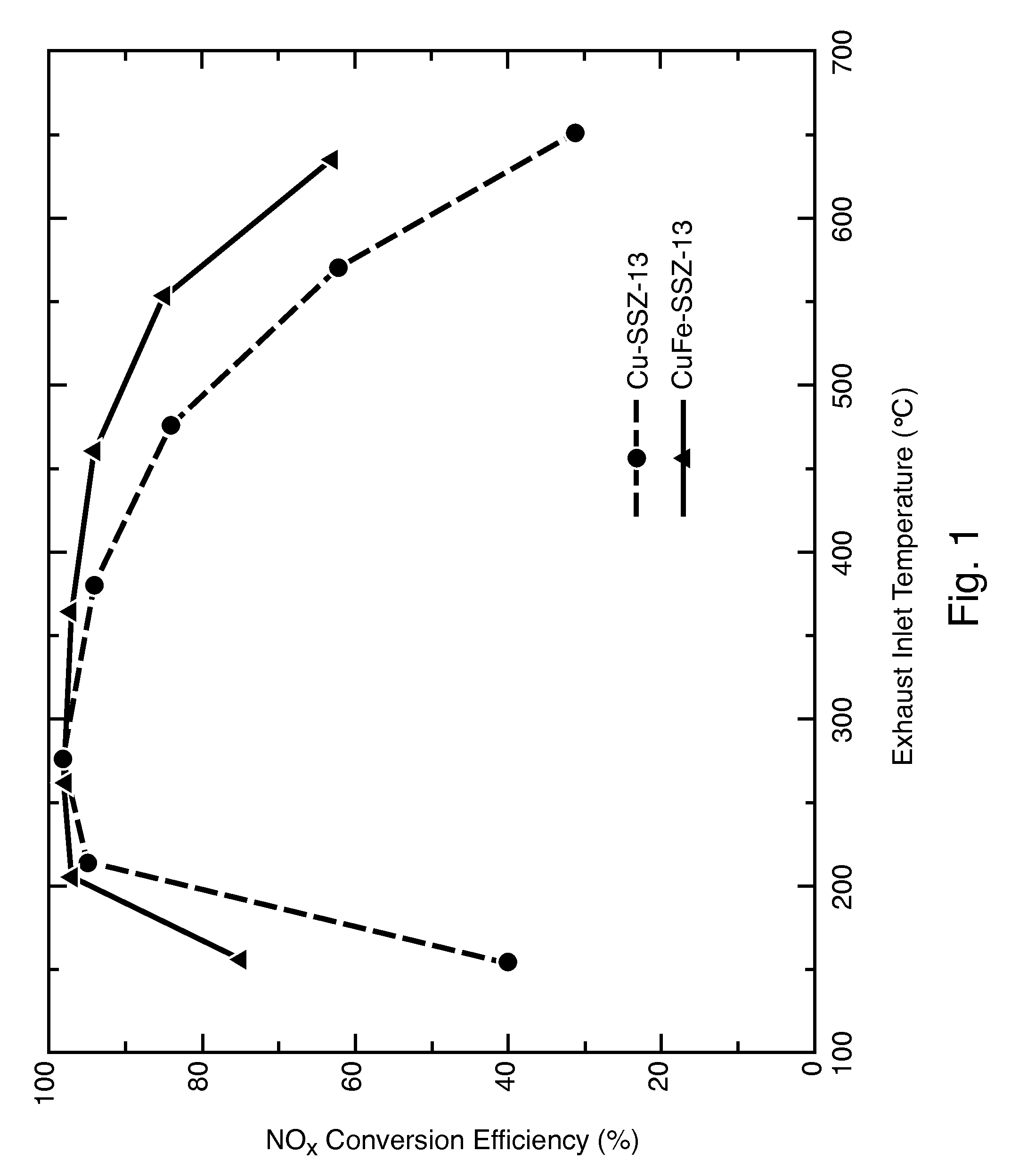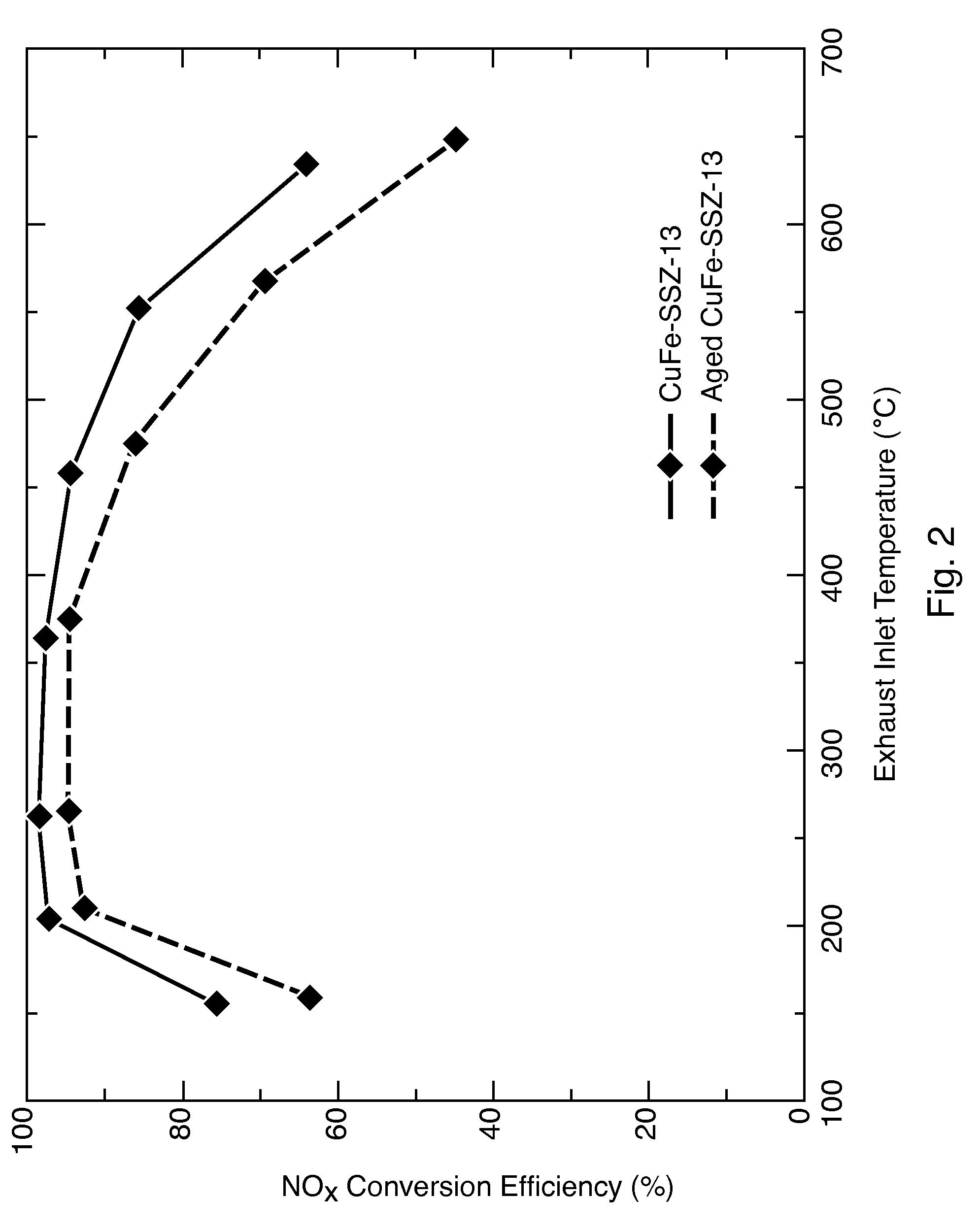Hydrothermally stable, low-temperature NOx reduction NH3-SCR catalyst
a catalyst and low-temperature technology, applied in the direction of physical/chemical process catalysts, silicon compounds, separation processes, etc., can solve the problems of not being able to efficiently remove nosub>x /sub>gases in diesel/lean gasoline engine lean emissions, not meeting epa regulatory requirements when used for diesel engines, and standard three-way catalysts work well for gasoline engines. , to achieve the effect of reducing nox emissions
- Summary
- Abstract
- Description
- Claims
- Application Information
AI Technical Summary
Benefits of technology
Problems solved by technology
Method used
Image
Examples
example i
[0057]H-SSZ-13 was prepared according to U.S. Pat. No. 4,544,538. Cu-SSZ-13 was synthesized as following: a 2.664 g sample of Cu(OAc)2.H2O was dissolved in 600 mL de-ionized water (0.022M), followed by addition of H-SSZ-13 (10.00 g). The slurry was stirred for 2 hours at 50° C. The blue colored solid was collected by filtration after cooling, washed with de-ionized water, and calcined in air at 500° C. (10° C. / min) for 4 hours to afford Cu-SSZ-13. Elemental analysis: Cu 3.46, Al 4.05%.
[0058]CuFe-SSZ-13 was obtained through procedures: 10 g Cu-SSZ-13 was suspended in a water solution of 50 mL 0.015M Fe(NO3)3, degassed with N2, and kept stirring for 2 hours at 80° C. Yellow solid was obtained after filtration, and the filtrate was clear and colorless. The product was then calcined in the air at 500° C. (2° C. / min) for 2 hours to yield pale yellow CuFe-SSZ-13. Elemental analysis: Cu 2.71%, Fe 0.357%, Al 3.86%.
example ii
[0059]Cu-SSZ-13 and CuFe-SSZ-13 catalyst powders were comparatively tested. The catalyst powders were mixed with equal amounts (by weight) of inert cordierite and transferred to a bench-top reactor. A de-greening was done in a flow of 8.5% O2, 8% CO2, and 7.25% H2O with balance N2 at a temperature of 600° C. (inlet gas temperature) and a space velocity of 50,000 h−1 for two hours. NOx conversion efficiency experiments employed simulated diesel exhaust containing 8.5% O2, 8% CO2, 7.25% H2O, 250 ppm NO2, 250 ppm NO, 500 ppm NH3, and N2 as balance at a space velocity of 50,000 h−1 and evaluated in the temperature range of 150° C. to 650° C. Results are shown in FIG. 1. Our catalyst, CuFe-SSZ-13 clearly shows better performance in 150-650° C. range. The NOx conversion performance difference is especially noticeable at 150° C. where Cu-SSZ-13 converts ˜40% NOx whereas CuFe-SSZ-13 converts ˜75% NOx under test conditions.
example iii
[0060]Accelerated aging was performed on the CuFe-SSZ-13 catalyst powder by employing an aging protocol that exposes catalyst to a temperature of 675° C. for 50 hours under a flow of air containing 10% water. Testing results are shown in FIG. 2.
[0061]Our catalyst, CuFe-SSZ-13, demonstrates high hydrothermal durability and has high NOx conversion performance in 150-650° C. range. The NOx reduction at 150° C. is ˜65% which is still better than fresh Cu-SSZ-13, as shown in FIG. 1.
PUM
| Property | Measurement | Unit |
|---|---|---|
| temperatures | aaaaa | aaaaa |
| temperatures | aaaaa | aaaaa |
| temperatures | aaaaa | aaaaa |
Abstract
Description
Claims
Application Information
 Login to View More
Login to View More - R&D
- Intellectual Property
- Life Sciences
- Materials
- Tech Scout
- Unparalleled Data Quality
- Higher Quality Content
- 60% Fewer Hallucinations
Browse by: Latest US Patents, China's latest patents, Technical Efficacy Thesaurus, Application Domain, Technology Topic, Popular Technical Reports.
© 2025 PatSnap. All rights reserved.Legal|Privacy policy|Modern Slavery Act Transparency Statement|Sitemap|About US| Contact US: help@patsnap.com


